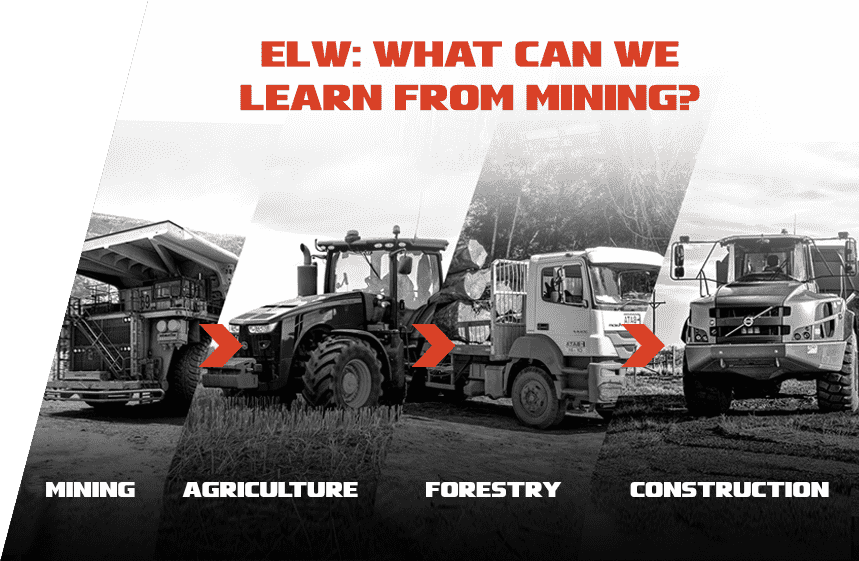What can Construction, Agriculture, Forestry Learn from Mining?
ELW (‘Elimination of Live Work’) is a term that’s well known in mining circles, but one that’s yet to fully transfer over into other heavy industry sectors like construction, agriculture and forestry. But what does it refer to, and should it be equally ‘top of mind’ cross-industry?
Although very distinct industries, mining, agriculture, construction and forestry all involve the use of heavy mobile equipment; be it trucks, dozers, graders, excavators. Granted, the mining spec vehicles tend to be on the larger side, but all mobile heavy equipment requires regular routine inspection and maintenance – pressure testing, calibration, etc.
Typically, that involves one or more maintenance technicians working inside the machine footprint, which is the definition (at least in mining) of ‘live work’.

Working up close next to highly-pressurised ‘live’ equipment certainly has its risks, with multiple moving parts, weighing potentially hundreds of tonnes. Maintenance crews are exposed to any number of potential hazards daily, that could result in drastic consequences.
A 2019 study found that between 1999-2019, in Queensland alone, 25% of all recorded mining fatalities were due to contact with heavy machinery – with maintenance workers becoming either crushed or entangled.*
That’s partly the reason why Western Australia Caterpillar dealer, WesTrac, embarked on its Elimination of Live Work (ELW) project back in 2018.
Working in collaboration with mining companies and Original Equipment Manufacturers (OEMs), the projects’ goal was to remove personnel from within the proximity of live equipment in up to 90 per cent of common maintenance tasks.
The project started off as a boost to workplace safety with one of WesTrac’s major mining clients, BHP, and went on to receive industry-wide attention and recognition. BHP presented WesTrac with a safety award for its ELW work, along with the project being recognised by the Department of Mines, Industry Regulation and Safety.
In 2020, WesTrac’s Newman branch manager, James Davey said “The purpose of this project is not to deal with little nicks and cuts, it’s about saving lives. If things go wrong when people are working on live equipment, the results could be disastrous.”**
The project involved a range of initiatives, but a key component was an ELW field service kit introduced by WesTrac that provides mobile and workshop-based mechanics with inspection and testing tools that prevent them from physically working near live equipment.
Flashforward to today, and SafeGauge’s wireless range of pressure transducers, dial indicators and tachometers are now a staple in many-a-mechanics’ field service kit – allowing them to perform routine testing from up to 50m distance (outside the machine footprint, and away from the danger zone).
Aside from the safety component, the SafeGauge kits also prove to be highly efficient. With readings taken digitally instead of analogue, technicians can take multiple readings from multiple gauges simultaneously – reducing maintenance times by up to 50%, thereby providing significant productivity gains.
Along the way, NSW-based SafeGauge has stacked up a number of industry awards and has expanded its operations globally, and not just in mining.
Luke Dawson, MD: “We’ve been really encouraged by the take-up overseas – we’ve now got a global network of resellers and a client base that includes virtually all the major miners, as well as OEMs and dealers.”
“What we’re just starting to see now, is cross-industry uptake into other sectors that have fleets of heavy mobile equipment – namely construction, agriculture, forestry.”
“Based on the types of equipment in those industries and the type of maintenance work carried out, the risks associated with ‘live work’ are inherently the same. The objective is to remove the technician out of the danger zone and eliminate the live component of the work.”
The industry data backs this up. According to the latest Safe to Work Australia report, agriculture/forestry and construction rank second and third in overall fatalities between 2016-2020, accounting for near 40% of the total. In 2020 alone, 25 workers (13%) were hit by a moving vehicle or machinery, and 3 out of 4 of total fatalities, across all sectors (194), involved a vehicle.** The risk-factor across these sectors could therefore exceed that in mining, both in Australia and overseas.
Luke Dawson, MD: “For those who work in mining as I have for many years, we know the focus the industry has on safety – it’s the first, second and final priority.”
“It’s encouraging to see that mindset is the same in other industries. The challenge for us and other safety solution providers is to raise awareness that new products and solutions exist – products that may have started out in mining but have multi-industry application.”
“Overall, we’re confident that the construction, agriculture and forestry sectors will embrace what we’ve got to offer and we’re already talking to multiple global CAT dealers and other OEMs about cross-industry application, so watch this space.”
SafeGauge will be exhibiting at the world’s largest agriculture and construction gathering, CONEXPO, in Las Vegas in March 2023, hoping to raise further awareness of ELW in the North American market.
References:
*https://documents.parliament.qld.gov.au/tableOffice/TabledPapers/2020/5620T197.pdf
**https://safetowork.com.au/westrac-to-prevent-maintenance-dangers-with-elw-project/

